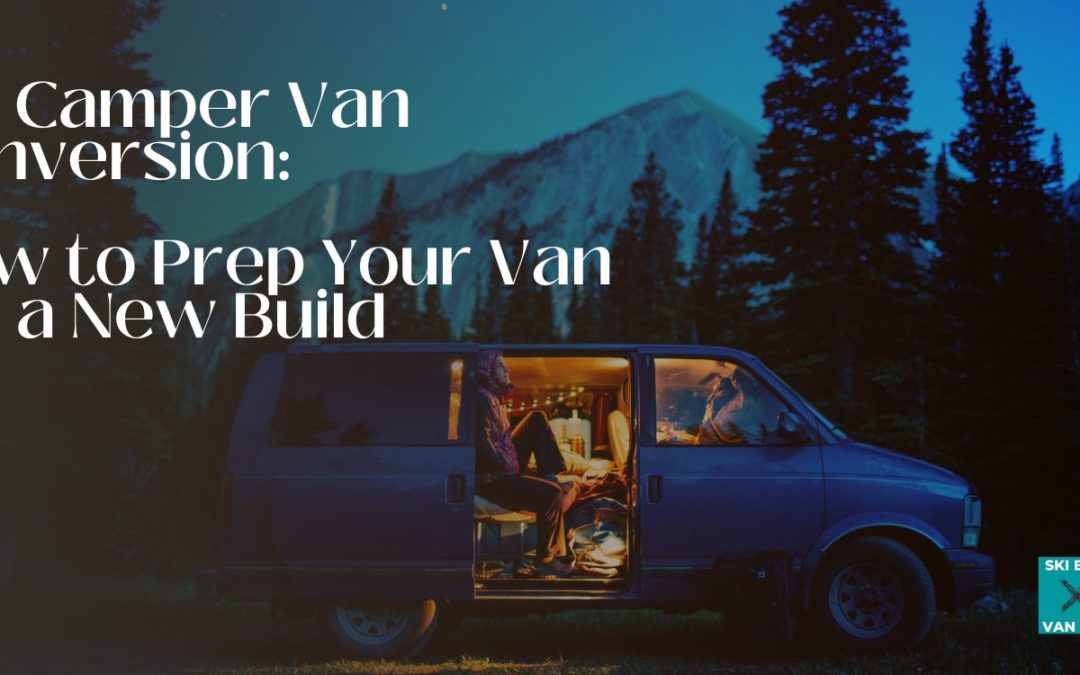Van life can be an incredible experience. It’s a great way to explore the world and see new places while still having all the comforts of home. But before you can hit the open road, there’s one important step you need to take: preparing your van for a new build.
To prep for a build, you first need to:
- Choose the right van
- Create a plan
- Decide what materials to use
- Perform repairs and maintenance
- Demo
- Install your electrical system
- Insulate the van
If you’re thinking about converting your van into a campervan, there are a few things you’ll need to do to prepare your van for the build. Here’s a quick guide on how to get started.
1. How to Choose the Right Van.
Not all vans are created equal when it comes to camper conversions. You’ll want to make sure you choose a van that’s the right size for your needs, with enough headroom and windows for your comfort. You’ll also want to consider things like fuel efficiency and reliability when making your decision. Our founder Frank went for a 2009 Toyota Sienna with all wheel drive and a 6 cylinder. It’s a true BAMF and has been taking him to shredding spots for multiple seasons now.
Some things to consider:
- Size: How much space do you need? Will you be traveling solo or with others?
- Headroom: You’ll need enough headroom to stand up comfortably inside the van.
- Windows: Windows will provide natural light and ventilation, so make sure your van has enough of them.
- Fuel efficiency: A fuel-efficient van will save you money on gas as you travel.
- Reliability: A reliable van will help you avoid breakdowns and unexpected repairs. On the other hand, new vans can be pricey, so you may consider buying a used van already in good shape.
Weigh the pros and cons of each category to decide what type of van would work best for you. Once you’ve narrowed it down, start shopping around and compare prices.
2. How to Create a Build Plan
After you’ve chosen the right van, it’s time to start planning your build. This is where you’ll decide what kind of layout you want, what type of furniture and appliances you’ll need, and how you’ll use the space. You’ll also need to factor in insulation, ventilation, and electrical systems.
Creating a plan will help you stay organized and on budget as you begin your build. Sketch out a few different layouts and decide what kind of furniture and appliances you need. Once you have a good idea of what you want, think about how you’ll use the space and what type of systems you’ll need to install.
3. Deciding What Materials to Use
There are a lot of different materials you can use to convert your van, so it’s important to choose the right ones for your needs. If you’re on a budget, you might consider using recycled materials or second-hand items. You can use new materials like plywood, paneling, and carpet for a more professional look.
This, of course, comes with a huge consideration to your budget, so make sure you factor that in when deciding what to use. If you’re looking for a more sustainable option, consider using recycled materials or second-hand items. You can find these items at:
- Local thrift store
- Online
- Garage sales, or
- Through friends and family.
If you’re unsure what to use, ask for advice from friends or family who have done similar projects. You can also look online for ideas and inspiration. Once you’ve decided on the materials you want to use, make a list of everything you’ll need.
4. How to Perform Repairs and Maintenance.
Before starting your build, it’s important to ensure your van is in good working order. This means performing necessary repairs and maintenance tasks, such as fixing leaks, replacing tires, and servicing the engine. You’ll also want to thoroughly clean the van with a drill brush or heavy-duty cleaning cloth to eliminate any dirt, dust, or grime.
Some of the most important to check for include:
- Leaks: Look for leaks in the roof, windows, or doors. If you find any, seal them up before starting your build.
- Tires: Check your tires’ tread and ensure they’re inflated to the proper pressure. If they’re worn out, consider replacing them before beginning your build.
- Oil changes: Getting an oil change is important for any vehicle, but it’s especially important for vans. This is because vans accumulate a lot of dirt and grime, which can clog the engine.
- Check the steering: Make sure the steering is tight, and there is no play in the wheel.
- Fluids: Check all of the fluid levels in the van and top them off if necessary.
- Check for rust: Inspect the van for any rust spots and use a rust remover or sand them down. You may need to replace the affected panel if the rust is severe.
If you’re not mechanically inclined, you can take your van to a mechanic for a tune-up before you start your build. This will help ensure that everything is in good working order and save you time and money down the road.
5. How to Demo Your Van Before Building
Once you’ve made all the necessary repairs and maintenance tasks, it’s time to start demoing your van. This is where you’ll remove any existing furniture or fixtures and strip the interior down to the bare essentials. This can be a time-consuming and messy process, so it’s important to be prepared.
Wear old clothes that you don’t mind getting dirty, and cover any areas you don’t want to demo. When you’re ready, remove any furniture or fixtures attached to the walls or floor. This includes things like
- Shelves, cabinets, and countertops (for RVs)
- Bench seats
- Passenger seats
- Spare tires
- Rear seatbelts, and
- Carpets
After that, you can start removing the wall paneling and ceiling. If you’re planning on insulation, you’ll need to remove the existing material first. Use a crowbar or screwdriver to remove any trim or molding around the windows and doors. Removing unnecessary items from your van will make the build process much easier and help save on weight and space.
6. Install your electrical system.
Because off-grid living requires a lot of power, you’ll need to install a robust electrical system in your van. This can be a daunting task, but there are many resources available to help you.
Alternating current and direct current are the two forms of electrical energy in van conversions:
- Alternating current is direct current that has been funneled through a device. 12V appliances and batteries are powered by it.
- Direct current moves one way only, requiring a positive and negative end. The motion of electrons is reversed using alternating current.
The components of a DIY van solar panel installation are as follows: battery, charge controller, inverter, and solar panels.
Batteries
Batteries ultimately store energy so it can be used later and are necessary for an off-grid power system. The most popular types of batteries used in van conversions are lead-acid and lithium-ion batteries.
Charge Controller
Charge controllers are devices that regulate the flow of electricity from the solar panels to the battery and prevent the battery from becoming overcharged and potentially damaged.
Inverter
Inverters are devices that convert direct current into alternating current. This is necessary for powering devices that use alternating current, such as laptops and phones. If you’re running a 12V system, an inverter isn’t required, but if you’re including household appliances or electronics, you’ll need one.
Inverters convert direct current to alternating current. Watts are used to measure inverters and should be big enough to handle your largest devices.
Solar Panels
Solar panels are the most important component of a solar power system, as they’re what generates electricity. The size and type of solar panel you need will depend on your power needs.
In ideal circumstances, a 100w solar panel can produce 30ah each day, so with three to 100w solar panels, you should be able to charge a 200ah battery in five full sunlight hours. Consider adding five or six panels to your roof or an extra detached panel on sunny days if you want to boost your overall energy input.
If you’re utilizing a solar panel kit, start by installing the panels on the roof of your van. Then, run the wiring from the panels to the battery and charge controller.
To install an electrical system:
- Connect your battery to your charge controller first.
- The charge controller should now turn on after you’ve connected your battery. If it doesn’t, there’s a chance that your batteries aren’t charged.
- Then connect the batteries to the inverter, and lastly, the solar panel wires to the charge controller.
- The charge controller should now be receiving power from the solar panels and sending it to the batteries.
Having your wiring complete and tested before adding insulation will make your life much easier. There are a ton of resources both online and from solar panel kit manufacturers that can help you with the wiring process. After your electrical system is installed, you can now start working on the interior of your van. This includes adding insulation, and eventually installing cabinets, and putting in flooring.
7. Install your insulation.
Insulation will help keep your van cool in the summer and warm in the winter. It’s also necessary for soundproofing. There are many different types of insulation, including:
Depending on who you ask, the two most popular for van conversions are fiberglass and spray foam. Fiberglass is the cheaper option and is easier to install, but it’s not as effective at insulating as spray foam. Spray foam is more expensive and more time-consuming to install, but it will better insulate your van.
To install fiberglass insulation:
- Cut it to size and fit it into the wall cavities.
- Use small nails, glue, or staples to secure it in place.
To install spray foam, you’ll need to rent or buy a spray foam machine or kit. Follow the instructions that come with the machine to apply the foam evenly to the walls.
No matter which type of insulation you choose, be sure to seal any gaps or cracks with caulk to prevent drafts. From this point, your van should be in good shape to start the build and customization process.
Conclusion
Building out a camper van can be a daunting task, but if you take the time to plan and prepare your van, the process will go much smoother. Be sure to consider your power needs, insulation, and ventilation when planning your build. And take your time! This is a big project, but the end result will be worth it.





Recent Comments